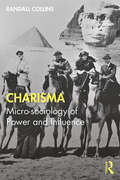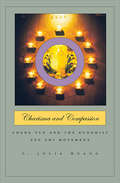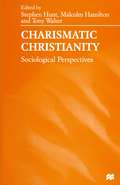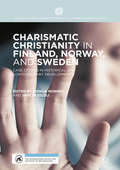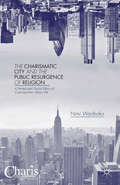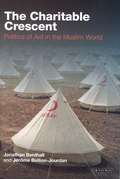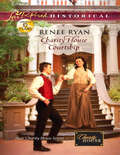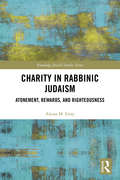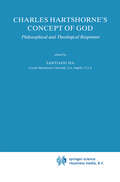- Table View
- List View
Charisma: Micro-sociology of Power and Influence
by Randall CollinsWhat is charisma? And how does it generate influence and power? World-renowned sociologist Randall Collins explores these and many other questions in a highly readable exploration of the various forms of charisma and how charisma elevated Jesus, Cleopatra, Lawrence of Arabia, Queen Elizabeth, Hitler, Churchill, Franklin and Eleanor Roosevelt, Madame Mao Zedong, and others. He explores four types of charisma: frontstage, backstage, success-magic, and reputational charisma. Not everyone has the same kind of charisma and Collin’s identifies important differences and their relations to power. The book exemplifies Collin’s sophisticated micro-sociology in accessible and compelling prose, quietly building subtle matrices of analysis that show how sociology unveils hidden discoveries.
Charisma and Compassion: Cheng Yen and the Buddhist Tzu Chi Movement
by C. Julia HuangThe Venerable Cheng-yen is an unassuming Taiwanese Buddhist nun who leads a worldwide social welfare movement with five million devotees in over thirty countries—with its largest branch in the United States. Tzu-Chi (Compassion Relief) began as a tiny, grassroots women's charitable group; today in Taiwan it runs three state-of-the-art hospitals, a television channel, and a university. Cheng-yen, who has been nominated for the Nobel Peace Prize, is a leader in Buddhist peace activism and has garnered recognition by Business Week as an entrepreneurial star. Based on extensive fieldwork in Taiwan, Malaysia, Japan, and the United States, this book explores the transformation of Tzu-Chi. C. Julia Huang offers a vivid ethnography that examines the movement’s organization, its relationship with NGOs and humanitarian organizations, and the nature of its Buddhist transnationalism, which is global in scope and local in practice. Tzu-Chi's identity is intimately tied to its leader, and Huang illuminates Cheng-yen's successful blending of charisma and compassion and the personal relationship between leader and devotee that defines the movement. This important book sheds new light on religion and cultural identity and contributes to our understanding of the nature of charisma and the role of faith-based organizations.
Charisma and Myth
by Raphael FalcoCharisma and Myth combines an interdisciplinary examination of myth with the newest developments in the application of charisma theory to history and social life. Through scores of examples ranging from Inuit myth to Christian theology, from Malinowski to martyrology, Charisma and Myth argues definitively that the survival of myth systems mirrors the survival of such charismatic groups as modern street gangs, the Anglo-Saxon comitatus, or Satan's fallen angels in Paradise Lost. Even the smallest charismatic group generates its own set of myths, and, like larger myth systems, depends on continual revolutionary change - not, as might be expected, on the stability of its myths - to survive and to achieve longevity. As this innovative study shows, group leaders must learn first to foster and then to manage the mild chaos and changing symbols of their myths. Charisma and Myth challenges myth theorists from the nineteenth through to the twenty-first century and adds a missing component to our understanding of how and why myths continue to grip our imaginations.
Charisma and Myth
by Raphael FalcoCharisma and Myth combines an interdisciplinary examination of myth with the newest developments in the application of charisma theory to history and social life. Through scores of examples ranging from Inuit myth to Christian theology, from Malinowski to martyrology, Charisma and Myth argues definitively that the survival of myth systems mirrors the survival of such charismatic groups as modern street gangs, the Anglo-Saxon comitatus, or Satan's fallen angels in Paradise Lost. Even the smallest charismatic group generates its own set of myths, and, like larger myth systems, depends on continual revolutionary change - not, as might be expected, on the stability of its myths - to survive and to achieve longevity. As this innovative study shows, group leaders must learn first to foster and then to manage the mild chaos and changing symbols of their myths. Charisma and Myth challenges myth theorists from the nineteenth through to the twenty-first century and adds a missing component to our understanding of how and why myths continue to grip our imaginations.
The Charismatic Century: The Enduring Impact of the Azusa Street Revival
by Jack W. Hayford S. David MooreThe most profound event in modern church history took place not in a cathedral but in a clapboard church in Los Angeles. A small congregation of mostly African American worshipers embraced the concept that New Testament signs and wonders were still available in the early twentieth century. Their dramatic spiritual revival, which became known as the Azusa Street Revival, attracted believers worldwide and launched the modern Pentecostal and Charismatic movements. This event forever changed Christian worship, music, and expression. In commemoration of Azusa Street's 100th anniversary, Jack Hayford tells the story, revealing how Christians are still experiencing its impact.
Charismatic Christianity: Sociological Perspectives
by Stephen J. Hunt Tony Walter Malcolm HamiltonThe charismatic movement has a high profile in contemporary Christianity. The book's contributors include insiders and outsiders, charismatics and sociologists; with Britain as their focus, they trace the movement's international connections, historical development and variety. The book provides a wealth of information and analysis which will interest both those within the movement and students of religion wanting to know more about it.
Charismatic Christianity in Finland, Norway, and Sweden: Case Studies in Historical and Contemporary Developments
by Jessica Moberg Jane SkjoldliThis is open access under a CC BY 4.0 licenseThe history of Charismatic Christianity in the Nordic countries reaches as far back as Pentecostalism itself. The bounds of these categories remain a topic of discussion, but Nordic countries have played a vital role in developing this rapidly spreading form of world-wide Christianity. Until now, research on global Charismatic Christianity has largely overlooked the region. This book addresses and analyzes its historical and contemporary trajectories in Finland, Norway, and Sweden. Through a selection of cases written by Nordic scholars from various disciplines, it demonstrates historical and contemporary diversity as well as interconnections between local, national, and global currents. Highlighting change and continuity, the anthology reveals new aspects of Charismatic Christianity.
Charismatic Christianity in Finland, Norway, and Sweden: Case Studies in Historical and Contemporary Developments
by Jessica Moberg Jane SkjoldliThis is open access under a CC BY 4.0 licenseThe history of Charismatic Christianity in the Nordic countries reaches as far back as Pentecostalism itself. The bounds of these categories remain a topic of discussion, but Nordic countries have played a vital role in developing this rapidly spreading form of world-wide Christianity. Until now, research on global Charismatic Christianity has largely overlooked the region. This book addresses and analyzes its historical and contemporary trajectories in Finland, Norway, and Sweden. Through a selection of cases written by Nordic scholars from various disciplines, it demonstrates historical and contemporary diversity as well as interconnections between local, national, and global currents. Highlighting change and continuity, the anthology reveals new aspects of Charismatic Christianity.
The Charismatic City and the Public Resurgence of Religion: A Pentecostal Social Ethics of Cosmopolitan Urban Life (Christianity and Renewal - Interdisciplinary Studies)
by N. WaribokoTwo powerful and interrelated transnational cultural expressions mark our epoch, Charismatic spirituality and global city. This book demonstrates how these two forces can be used to inform ethical design of cities and their common social lives to best support human flourishing, spirituality, and social and ecological wellbeing of their residents.
Charismatic Healers in Contemporary Africa: Deliverance in Muslim and Christian Worlds (Bloomsbury Advances in Religious Studies)
by Sandra Fancello and Alessandro GusmanBased on ethnographic studies conducted in several African countries, this volume analyses the phenomenon of deliverance – which is promoted both in charismatic churches and in Islam as a weapon against witchcraft – in order to clarify the political dimensions of spiritual warfare in contemporary African societies. Deliverance from evil is part and parcel of the contemporary discourse on the struggle against witchcraft in most African contexts. However, contributors show how its importance extends beyond this, highlighting a pluralism of approaches to deliverance in geographically distant religious movements, which coexist in Africa. Against this background, the book reflects on the responsibilities of Pentecostal deliverance politics within the condition of 'epistemic anxiety' of contemporary African societies – to shed light on complex relational dimensions in which individual deliverance is part of a wider social and spiritual struggle. Spanning across the study of religion, healing and politics, this book contributes to ongoing debates about witchcraft and deliverance in Africa.
Charismatic Healers in Contemporary Africa: Deliverance in Muslim and Christian Worlds (Bloomsbury Advances in Religious Studies)
Based on ethnographic studies conducted in several African countries, this volume analyses the phenomenon of deliverance – which is promoted both in charismatic churches and in Islam as a weapon against witchcraft – in order to clarify the political dimensions of spiritual warfare in contemporary African societies. Deliverance from evil is part and parcel of the contemporary discourse on the struggle against witchcraft in most African contexts. However, contributors show how its importance extends beyond this, highlighting a pluralism of approaches to deliverance in geographically distant religious movements, which coexist in Africa. Against this background, the book reflects on the responsibilities of Pentecostal deliverance politics within the condition of 'epistemic anxiety' of contemporary African societies – to shed light on complex relational dimensions in which individual deliverance is part of a wider social and spiritual struggle. Spanning across the study of religion, healing and politics, this book contributes to ongoing debates about witchcraft and deliverance in Africa.
The Charismatic Leadership Phenomenon in Radical and Militant Islamism (Religion and International Security)
by Haroro J. IngramHaroro J. Ingram journeys through over a century of history, from the Islamist modernists of the late-1800s into the 21st century, in the first full length examination of the charismatic leadership phenomenon in Islamist radicalism and militancy. Exhaustively researched and founded upon a suite of innovative multidisciplinary paradigms, this book features case studies of Hassan al-Banna, Sayyid Qutb, Abdullah Azzam, Osama Bin Laden and Anwar al-Awlaki. At a micro-level, Ingram argues that charismatic leaders act as vehicles for the evolution of modern Islamist radicalism and militancy. At a macro-level, he argues that the transformative charisma phenomenon in Islamist radicalism and militancy produces complex chains of charismatic leaders as individual figures rise by leveraging, to varying degrees, the charismatic capital of preceding charismatic leaders. Within these case studies, Ingram offers new approaches to understanding the nuances of these complex phenomena; from his ideal-types of charismatic leadership in Islamist militancy (spiritual guides, charismatic leaders and neo-charismatic leaders) to his framing of al-Qaeda as a ’charismatic adhocracy’. The result is an authoritative analysis of a phenomenon largely ignored by scholars of both charismatic leadership and Islamism. Ultimately, this ground-breaking investigation offers important insights into the complex nuances that drive the rise and evolution of not only Islamist militancy but radical and militant groups more broadly.
The Charismatic Leadership Phenomenon in Radical and Militant Islamism (Religion and International Security)
by Haroro J. IngramHaroro J. Ingram journeys through over a century of history, from the Islamist modernists of the late-1800s into the 21st century, in the first full length examination of the charismatic leadership phenomenon in Islamist radicalism and militancy. Exhaustively researched and founded upon a suite of innovative multidisciplinary paradigms, this book features case studies of Hassan al-Banna, Sayyid Qutb, Abdullah Azzam, Osama Bin Laden and Anwar al-Awlaki. At a micro-level, Ingram argues that charismatic leaders act as vehicles for the evolution of modern Islamist radicalism and militancy. At a macro-level, he argues that the transformative charisma phenomenon in Islamist radicalism and militancy produces complex chains of charismatic leaders as individual figures rise by leveraging, to varying degrees, the charismatic capital of preceding charismatic leaders. Within these case studies, Ingram offers new approaches to understanding the nuances of these complex phenomena; from his ideal-types of charismatic leadership in Islamist militancy (spiritual guides, charismatic leaders and neo-charismatic leaders) to his framing of al-Qaeda as a ’charismatic adhocracy’. The result is an authoritative analysis of a phenomenon largely ignored by scholars of both charismatic leadership and Islamism. Ultimately, this ground-breaking investigation offers important insights into the complex nuances that drive the rise and evolution of not only Islamist militancy but radical and militant groups more broadly.
The Charismatic Movement in Taiwan from 1945 to 1995: Clashes, Concord, and Cacophony (Christianity and Renewal - Interdisciplinary Studies)
by Judith C.P. LinThis book presents a comprehensive account of the historical development of the Charismatic Movement in Taiwan, placing it within the context of Taiwan’s religious and political history. Judith C. P. Lin unearths invaluable sources of the Japan Apostolic Mission, the Full Gospel Business Men’s Fellowship International Formosa Chapter, and Jean Stone Willans’ short stay in Taiwan in 1968. Lin describes and analyzes how the efforts of 1970s charismatic missionaries in Taiwan—including Pearl Young, Nicholas Krushnisky, Donald Dale, Allen J. Swanson, and Ross Paterson—shaped the theological convictions of later Taiwanese charismatic leaders. She also explores significant developments in the Taiwanese Church which contributed to the gradual and widespread recognition of the Charismatic Movement in Taiwan from 1980 to 1995. Lin offers a thorough treatment of history, reconfigures historiography from a Taiwanese perspective, and challenges the academic circle to take seriously the “Taiwanese consciousness” when engaging Taiwan’s history.
The Charitable Crescent: Politics of Aid in the Muslim World
by Jonathan Benthall Jérôme Bellion-JourdanIslamic Charity Under Suspicion': such headlines have become familiar since the attacks on the United States on 9.11. The Charitable Crescent is a unique and original account of a hitherto little-known field of pivotal significance to our understanding of the Muslim world today: the relationship between politics and philanthropy in the workings of Islamic charities. Based on years of research, Jonathan Benthall and Jerome Bellion-Jourdan explain the long tradition of philanthropy in Muslim history and how it is constantly adapted to differing political contexts. The pervasive connections between charity and politics in the Middle East demonstrate how naïve it is to think of humanitarianism as a sphere distinct from politics. The Charitable Crescent covers all aspects of this topic that has become so relevant in today's world: who is entitled to benefit from Muslim alms? Can material relief aid be de-linked from political, or sometimes even violent, action? How can public trust (both Western and Islamic) in welfare delivery systems be won? Who is entitled to interpret Islamic doctrine? Is there one universal tradition of humanitarianism, or many traditions defined by cultural history? This book offers rich practical insights highly relevant to today's highly tense international climate, and also encourages the reader to challenge the common Western assumption that 'we' are the exclusive providers of aid to rescue a passive Third World."Interesting, rewarding and timely - this is an important book" - 'Caroline Moorhead.'
Charity House Courtship (Charity House #5)
by Renee RyanFOR THE CHILDREN Thanks to a troubled childhood, Laney O’Connor knows the struggles faced by the offspring of society’s most desperate women. These young innocents need a safe place, which Laney seeks to provide at Charity House. When foreclosure threatens her haven, she’ll let nothing stop her from keeping the orphanage open.
Charity in Rabbinic Judaism: Atonement, Rewards, and Righteousness (Routledge Jewish Studies Series)
by Alyssa M. GrayStudying the many ideas about how giving charity atones for sin and other rewards in late antique rabbinic literature, this volume contains many, varied, and even conflicting ideas, as the multiplicity must be recognized and allowed expression. Topics include the significance of the rabbis’ use of the biblical word "tzedaqah" as charity, the coexistence of the idea that God is the ultimate recipient of tzedaqah along with rabbinic ambivalence about that idea, redemptive almsgiving, and the reward for charity of retention or increase in wealth. Rabbinic literature’s preference for "teshuvah" (repentance) over tzedeqah to atone for sin is also closely examined. Throughout, close attention is paid to chronological differences in these ideas, and to differences between the rabbinic compilations of the land of Israel and the Babylonian Talmud. The book extensively analyzes the various ways the Babylonian Talmud especially tends to put limits on the divine element in charity while privileging its human, this-worldly dimensions. This tendency also characterizes the Babylonian Talmud’s treatment of other topics. The book briefly surveys some post-Talmudic developments. As the study fills a gap in existing scholarship on charity and the rabbis, it is an invaluable resource for scholars and clergy interested in charity within comparative religion, history, and religion.
Charity in Rabbinic Judaism: Atonement, Rewards, and Righteousness (Routledge Jewish Studies Series)
by Alyssa M. GrayStudying the many ideas about how giving charity atones for sin and other rewards in late antique rabbinic literature, this volume contains many, varied, and even conflicting ideas, as the multiplicity must be recognized and allowed expression. Topics include the significance of the rabbis’ use of the biblical word "tzedaqah" as charity, the coexistence of the idea that God is the ultimate recipient of tzedaqah along with rabbinic ambivalence about that idea, redemptive almsgiving, and the reward for charity of retention or increase in wealth. Rabbinic literature’s preference for "teshuvah" (repentance) over tzedeqah to atone for sin is also closely examined. Throughout, close attention is paid to chronological differences in these ideas, and to differences between the rabbinic compilations of the land of Israel and the Babylonian Talmud. The book extensively analyzes the various ways the Babylonian Talmud especially tends to put limits on the divine element in charity while privileging its human, this-worldly dimensions. This tendency also characterizes the Babylonian Talmud’s treatment of other topics. The book briefly surveys some post-Talmudic developments. As the study fills a gap in existing scholarship on charity and the rabbis, it is an invaluable resource for scholars and clergy interested in charity within comparative religion, history, and religion.
Charles Borromeo: Selected Orations, Homilies and Writings
by Charles Borromeo John R. Cihak Ansgar SantogrossiCharles Borromeo (1538-1584) became the driving force of reform within the Catholic Church in the wake of the Council of Trent following the Protestant Reformation and the primary reason Trent's dramatic reforms were successful. His remarkable accomplishments in Milan as Archbishop became the model of reform for the rest of Western Europe. Change is never easy, but St. Charles' approach – deeply biblical, personal, practical and centered on Christ – offers a road map of reform, even for today. Now for the first time in over 400 years a significant selection of his works appears in the English language.Chapter 1 offers three orations that St Charles gave as Archbishop of Milan to the other Bishops. These texts were among those that Pope Paul VI sent out to the Bishops of the world in 1963 during Vatican II. Chapter 2 contains a selection of homilies on the Eucharist and is followed by a collection of texts that treat the reform of the clergy. The final chapter presents Borromeo's efforts at mobilizing the laity in their own reform.This translation is intended to be faithful to Borromeo's Latin or Italian texts rendered into contemporary English.
Charles Borromeo: Selected Orations, Homilies and Writings
by Charles Borromeo Fr John R. CihakCharles Borromeo (1538-1584) became the driving force of reform within the Catholic Church in the wake of the Council of Trent following the Protestant Reformation and the primary reason Trent's dramatic reforms were successful. His remarkable accomplishments in Milan as Archbishop became the model of reform for the rest of Western Europe. Change is never easy, but St. Charles' approach – deeply biblical, personal, practical and centered on Christ – offers a road map of reform, even for today. Now for the first time in over 400 years a significant selection of his works appears in the English language.Chapter 1 offers three orations that St Charles gave as Archbishop of Milan to the other Bishops. These texts were among those that Pope Paul VI sent out to the Bishops of the world in 1963 during Vatican II. Chapter 2 contains a selection of homilies on the Eucharist and is followed by a collection of texts that treat the reform of the clergy. The final chapter presents Borromeo's efforts at mobilizing the laity in their own reform.This translation is intended to be faithful to Borromeo's Latin or Italian texts rendered into contemporary English.
Charles Ellis Johnson and the Erotic Mormon Image
by Mary CampbellOn September 25, 1890, the Mormon prophet Wilford Woodruff publicly instructed his followers to abandon polygamy. In doing so, he initiated a process that would fundamentally alter the Latter-day Saints and their faith. Trading the most integral elements of their belief system for national acceptance, the Mormons recreated themselves as model Americans. Mary Campbell tells the story of this remarkable religious transformation in Charles Ellis Johnson and the Erotic Mormon Image. One of the church’s favorite photographers, Johnson (1857–1926) spent the 1890s and early 1900s taking pictures of Mormonism’s most revered figures and sacred sites. At the same time, he did a brisk business in mail-order erotica, creating and selling stereoviews that he referred to as his “spicy pictures of girls.” Situating these images within the religious, artistic, and legal culture of turn-of-the-century America, Campbell reveals the unexpected ways in which they worked to bring the Saints into the nation’s mainstream after the scandal of polygamy. Engaging, interdisciplinary, and deeply researched, Charles Ellis Johnson and the Erotic Mormon Image demonstrates the profound role pictures played in the creation of both the modern Church of Jesus Christ of Latter-day Saints and the modern American nation.
Charles Ellis Johnson and the Erotic Mormon Image
by Mary CampbellOn September 25, 1890, the Mormon prophet Wilford Woodruff publicly instructed his followers to abandon polygamy. In doing so, he initiated a process that would fundamentally alter the Latter-day Saints and their faith. Trading the most integral elements of their belief system for national acceptance, the Mormons recreated themselves as model Americans. Mary Campbell tells the story of this remarkable religious transformation in Charles Ellis Johnson and the Erotic Mormon Image. One of the church’s favorite photographers, Johnson (1857–1926) spent the 1890s and early 1900s taking pictures of Mormonism’s most revered figures and sacred sites. At the same time, he did a brisk business in mail-order erotica, creating and selling stereoviews that he referred to as his “spicy pictures of girls.” Situating these images within the religious, artistic, and legal culture of turn-of-the-century America, Campbell reveals the unexpected ways in which they worked to bring the Saints into the nation’s mainstream after the scandal of polygamy. Engaging, interdisciplinary, and deeply researched, Charles Ellis Johnson and the Erotic Mormon Image demonstrates the profound role pictures played in the creation of both the modern Church of Jesus Christ of Latter-day Saints and the modern American nation.
Charles Ellis Johnson and the Erotic Mormon Image
by Mary CampbellOn September 25, 1890, the Mormon prophet Wilford Woodruff publicly instructed his followers to abandon polygamy. In doing so, he initiated a process that would fundamentally alter the Latter-day Saints and their faith. Trading the most integral elements of their belief system for national acceptance, the Mormons recreated themselves as model Americans. Mary Campbell tells the story of this remarkable religious transformation in Charles Ellis Johnson and the Erotic Mormon Image. One of the church’s favorite photographers, Johnson (1857–1926) spent the 1890s and early 1900s taking pictures of Mormonism’s most revered figures and sacred sites. At the same time, he did a brisk business in mail-order erotica, creating and selling stereoviews that he referred to as his “spicy pictures of girls.” Situating these images within the religious, artistic, and legal culture of turn-of-the-century America, Campbell reveals the unexpected ways in which they worked to bring the Saints into the nation’s mainstream after the scandal of polygamy. Engaging, interdisciplinary, and deeply researched, Charles Ellis Johnson and the Erotic Mormon Image demonstrates the profound role pictures played in the creation of both the modern Church of Jesus Christ of Latter-day Saints and the modern American nation.
Charles Ellis Johnson and the Erotic Mormon Image
by Mary CampbellOn September 25, 1890, the Mormon prophet Wilford Woodruff publicly instructed his followers to abandon polygamy. In doing so, he initiated a process that would fundamentally alter the Latter-day Saints and their faith. Trading the most integral elements of their belief system for national acceptance, the Mormons recreated themselves as model Americans. Mary Campbell tells the story of this remarkable religious transformation in Charles Ellis Johnson and the Erotic Mormon Image. One of the church’s favorite photographers, Johnson (1857–1926) spent the 1890s and early 1900s taking pictures of Mormonism’s most revered figures and sacred sites. At the same time, he did a brisk business in mail-order erotica, creating and selling stereoviews that he referred to as his “spicy pictures of girls.” Situating these images within the religious, artistic, and legal culture of turn-of-the-century America, Campbell reveals the unexpected ways in which they worked to bring the Saints into the nation’s mainstream after the scandal of polygamy. Engaging, interdisciplinary, and deeply researched, Charles Ellis Johnson and the Erotic Mormon Image demonstrates the profound role pictures played in the creation of both the modern Church of Jesus Christ of Latter-day Saints and the modern American nation.
Charles Hartshorne's Concept of God: Philosophical and Theological Responses (Studies in Philosophy and Religion #12)
by Santiago SiaCharles Hartshorne's considerable writings have been influential in contem 1 porary religious and philosophical thought. Not only is he regarded as the leading living representative of process thought as well as a much respected interpreter of Whitehead, but he has also established himself as an original 2 and creative thinker in his own right. The literature on his philosophy has been rapidly increasing. His thought and influence have also been the subject 3 of a number of conferences and gatherings of scholars. One of Hartshorne's most notable contributions to contemporary philoso 4 phy and theology is his concept of God. In his writings he has set out "to formulate the idea of deity so as to preserve, perhaps increase, its religious value, while yet avoiding the contradictions which seem inseparable from the 5 idea as customarily defined." The result of his efforts has been the develop ment of the concept of a "dipolar God" (insofar as contrasting metaphysical predicates, e.g. relative/absolute, contingent/necessary, finite/infinite and so on, are affirmed as applicable to God although always in an eminent way). Inasmuch as he has elaborated this concept in close dialogue with classical theism, he also refers to it as "neo-classical". Because of the emphasis he places on the reality of change and becoming in his metaphysics (which regards God as the chief exemplification of metaphysical principles), the term 6 "process" has likewise been used to describe his notion of God.
